Feeling a little tired? There’s yoga for that. In fact, there’s yoga for just about everything. Yoga is a mental and physical practice that allows individuals to heal their bodies, and it can be beneficial for anyone; a student with great strength can be challenged, and a student with a disability can also access the exercise. It doesn’t require kettlebells or weighted balls, and you can practice in a space no larger than your bedroom.
Yoga has been traced as far back as 3000 B.C. with archeological evidence depicting figures performing yoga postures. Since then, it’s come a long way. It’s now being introduced into classrooms, practiced in parks, and even prescribed by doctors.
Research supports the benefits that practitioners have noticed for over 5,000 years. Studies find that it is excellent for increasing awareness, lowering stress, building confidence, managing back problems and ADD, and helping our bodies fight off heart disease, chronic pain, arthritis, and so much more. There is no known limit to yoga.
As a certified yoga teacher, I suggest that people search for a practice that is specific to their needs. There are many different kinds of yoga, and classes at a local studio may introduce you to the style that suits your needs best. In the meantime, begin with this short introduction. This particular sequence includes postures that will stretch, strengthen, and energize your body. It will increase blood flow in ways that will stimulate muscles, help focus the mind, and prepare you for the day. The poses are organized in a way that will allow beginners and experienced yoga students to practice and complete the sequence in 10 to 15 minutes.
Child’s Pose (Balasana)
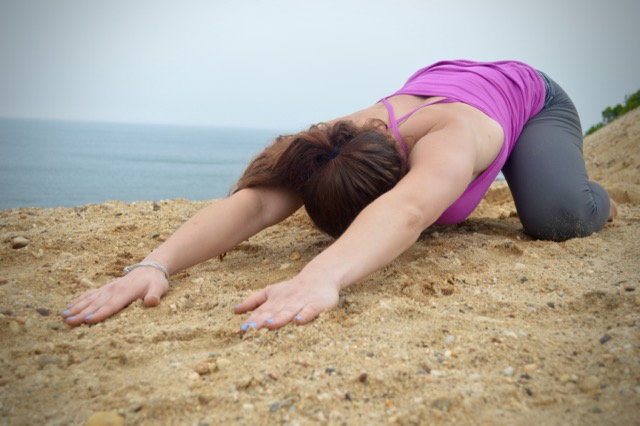
Amanda Loevner practicing Child's Pose (Katelyn Brush)
While kneeling on the floor, pull your hips down onto your heels, reach your arms out in front of you, and lay your forehead down on the ground. Focus on your breathing. Relax. In this pose, your knees can either be together for support or spread apart to open the hips, receiving a deeper stretch. If you struggle to bring your hips down onto your heels comfortably, place a pillow behind your thighs. Stretching your fingertips wide and lengthening your spine in this posture will relieve tension in your lower back.
Benefits:
- Stretches the hips, thighs, and ankles (great for runners!)
- Relieves stress, anxiety, dizziness, and fatigue
- Encourages steady, deep breathing
- Increases blood flow to the brain, thereby calming the nervous system
- Allows the body to relieve stress and tension
Downward-Facing Dog (Adho Mukha Svanasana)
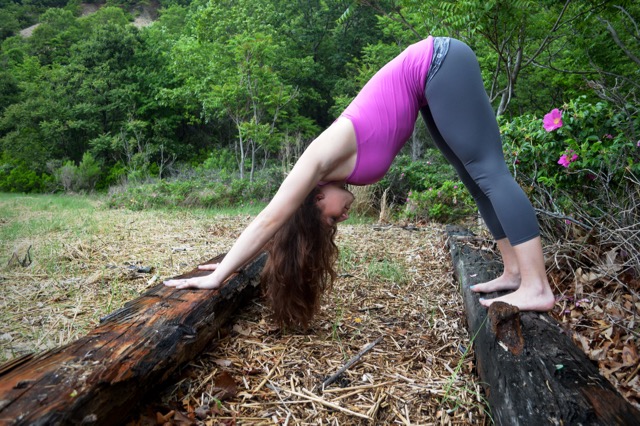
Yoga teacher, Amanda Loevner posing in Downward Facing Dog (Katelyn Brush)
From child’s pose, tuck your toes, press the ball mounds of your feet into the ground and lift your hips up, distributing your weight evenly among all four limbs. Begin to pedal out your feet to wake up the calf muscles, then slow it down and press your heels into the floor. To protect your shoulders, lift your chest in between your shoulder blades, wrapping your ribs around your heart. Your body should look like an upside down letter V. Don’t stress the muscles in your neck; let your head hang.
Benefits:
- Stretches the backs of the legs, bottoms of the feet, shoulders, and hands
- Strengthens the arms and legs
- Relieves menstrual discomfort, headaches, insomnia, back pain, and fatigue
- Increases blood flow to the brain, thereby calming the nervous system
- Allows the body to relieve stress and tension
Warrior I (Virabhadra I)
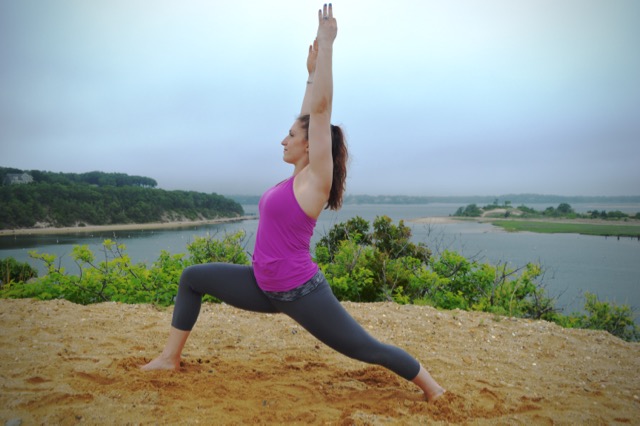
Yoga teacher, Amanda Loevner practicing Warrior I (Katelyn Brush)
From downward-facing dog, step your left foot forward, in between your hands. Pull you right heel down to the ground at a 45-degree angle. Bringing your palms to face one another, rise up with long arms, pointing your fingertips upward. Bring your gaze straight ahead of you (or for a deeper stretch, look up). Protect your left knee by bringing it directly over your left ankle.
Benefits:
- Stretches the muscles in the chest, lungs, neck, belly, shoulders, hip flexors, groin, and ankles
- Strengthens the legs, ankles, arms, shoulders, abdomen, and back
- Improves balance and concentration
Warrior II (Virabhadra II)
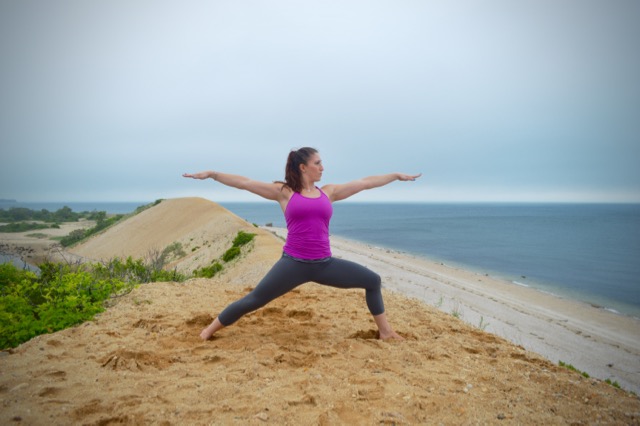
Amanda Loevner practicing Warrior II (Katelyn Brush)
Maintaining your leg stance, open your arms parallel to the ground and open your hips to the side. Because your left foot is forward, your left arm should also be reaching forward, above the front leg, while the right arm reaches back. Bring your gaze over your front hand and stand tall by tucking your tailbone. This will protect your lower back.
Benefits:
- Stretches the muscles in the chest, lungs, neck, belly, shoulders, hip flexors, groin, and ankles
- Strengthens the legs, ankles, arms, shoulders, abdomen, and back
- Improves balance and concentration
Peaceful Warrior

Amanda Loevner practicing Peaceful Warrior (Katelyn Brush)
You’ve developed a strong warrior stance; now, take it on back! Flip your front hand so the palm faces up and place your back hand on the back leg. Lean back while distributing the weight equally (you have to engage your core and back muscles to do so). Bring your gaze up to your hand. Remember to protect your front knee by keeping it over the ankle.
Benefits:
- Stretches the legs, back, arms, groin, shoulders, and abdomen
- Strengthens the legs, back, and abdomen
- Improves balance, concentration, and core awareness
- Increases back flexibility and spine health
Tree
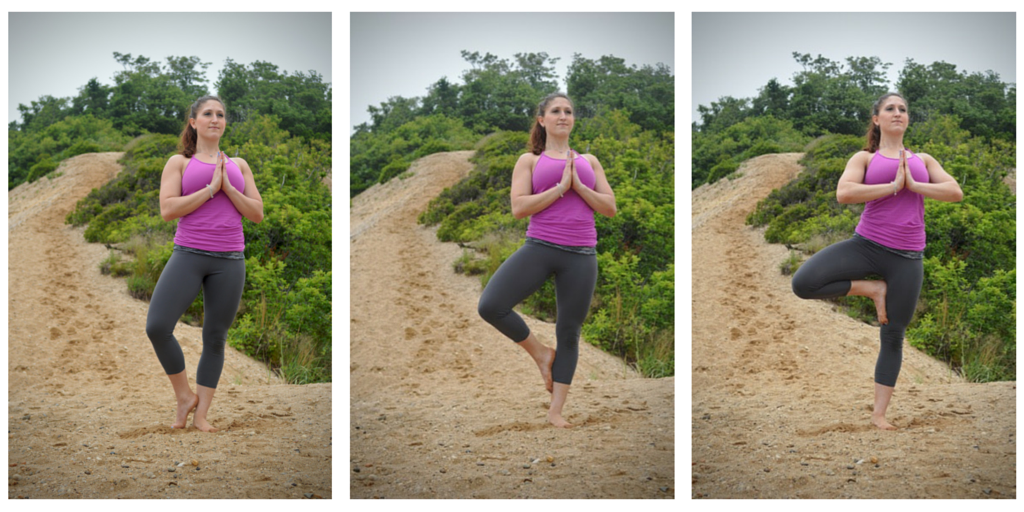
Amanda Loevner practicing Tree Pose variations (Katelyn Brush)
Releasing the peaceful warrior pose, step your back foot forward and come to a standing position. Keep your standing leg (left leg for the first round) planted, allowing your weight to be distributed throughout that foot. Begin to pull your right knee up, then turn the knee outward and place the foot on the inside of the standing leg. Tree pose has multiple modifications and advancements. To modify the pose, you may place the ball mounds of the right foot on the ground and rest the heel on the left ankle like a kickstand. To advance the pose, you can bring the right foot on the inside of the left calf or thigh. More experienced practitioners can grab onto the right foot, flip the arch of the foot upward and place the outside of the foot on top of the left thigh.

Amanda Loevner practicing Tree Pose with a Half Lotus variation (Katelyn Brush)
Wherever your foot is placed, find your balance by bringing your gaze to a Drishti, also known as a focus point. Bring your hands to your heart, then try to keep your balance as you extend your arms upward. This extension alleviates tension in the spine and increases concentration.
Benefits:
- Stretches the thighs, groin, abdomen, and shoulders
- Strengthens the thighs, calves, ankles, and spine
- Improves spine health
- Therapeutic for back ailments like scoliosis, sciatica, osteoporosis, and more
Now
Go through the sequence again, except this time, step your right foot forward instead of your left in the warrior poses and use your right foot as your standing foot in tree pose. This will stretch the other side of your body and even things out.
Afterward, lie in savasana, the relaxing, restorative, and most enjoyable position of them all. Savasana (pronounced Shah-va-sana), also known as corpse pose or final relaxation pose, is how all practices are ended in yoga.
Don’t underestimate the power of this meditative position. Science has shown that practicing savasana allows the body to heal itself by lowering blood pressure. It also flips the switch from the sympathetic nervous system to the parasympathetic nervous system, which empowers bodily function. Lie here for a few minutes, focusing on slowing down your breathing. When you’re ready, get up and seize the day!
-
Yoga for Detoxing from the Weekend
-
Why I Joined and Why I Quit: A Softball Story
-
How to Be Smart in Our National Parks This Summer
-
How to Keep Your Brain Active Over Summer Vacation
-
Eight Ways to Stay Fit during the Winter Months without Hitting the Gym
-
15 Ways to Avoid Gaining the Freshman 15
-
The Truth: Why You Should Get Fit to Finish the School Year
-
Easy Ways to Stay Fit When You’re Busy with School
-
Six Yoga Poses to Help with Anxiety and Panic Attacks

